Homemade Croutons
Homemade Croutons using fresh bread are a thousand times better than storebought, and they’re incredibly simple to make! They’re truly worth your while, and a batch can be made in less than 20 minutes. These will become your secret weapon in making the most epic salads at home.
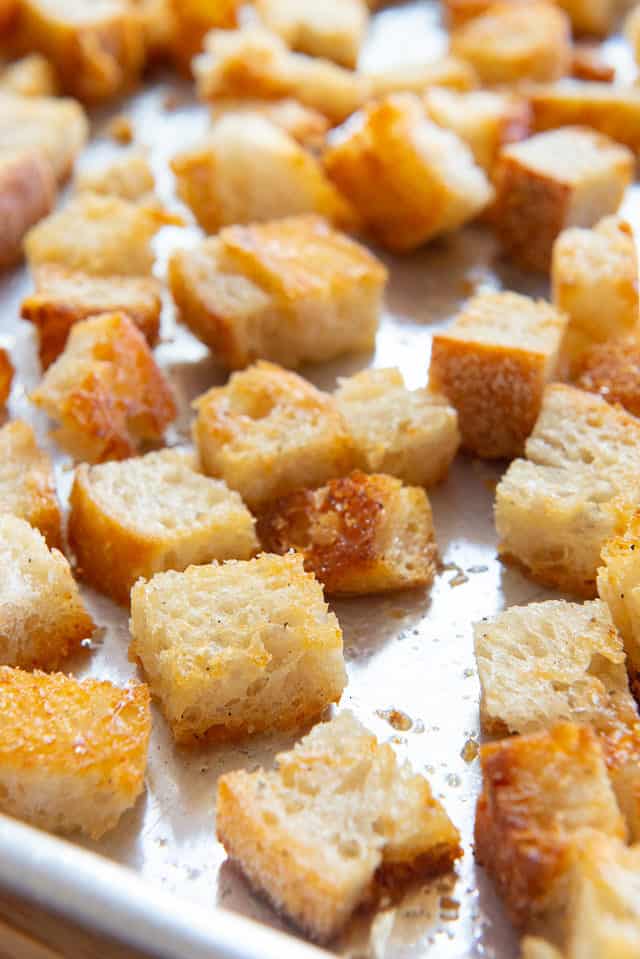
I know you can buy croutons at the store, but my problem with store-bought croutons is that they have absolutely zero moisture to them and consequently taste like cubes of styrofoam.
I understand that they can’t have moisture, since they have to last on the shelf for months, and if they had water in them, that wouldn’t work for shelf storage. But that lack of moisture makes for croutons that are dry and crumbly, with a staleness that overall makes them a dealbreaker for me.
Salads hinge so much on how much effort you put into the ingredients, and homemade croutons can make them really special and delicious. Plus, it’s a great way to use up leftover bread!
In addition to green salads, you can even use them to elevate homemade soups like this Tomato Bisque, which greatly benefits from a few croutons on top!
Tips for Best Results
Use day-old bread if possible – I’ve used fresh bread when it’s all I’ve had, and it’s still good, but croutons are a little better when using leftover bread that’s a day or two old. This is because it’s slightly dried out and yields a superior texture that’s less spongey.
Use a flavorful fat for toasting – The fat that you choose to drizzle on the bread cubes is not just important for toasting and crisping, but also for flavor. Butter is in my opinion the most delicious, but olive oil works well too. Though not traditional, feel free to try other flavorful animal fats, like duck fat, tallow, or even lard. Duck fat croutons are amazing!
Decide to tear or cut – If this is your first time ever making croutons, you may want to compare a batch of torn bread croutons, and a batch of cut croutons. The torn bread will give you a more rustic and craggy texture, whereas cutting into uniform cubes is more traditional. They are texturally different, and neither one is necessarily better, it’s just what you prefer.
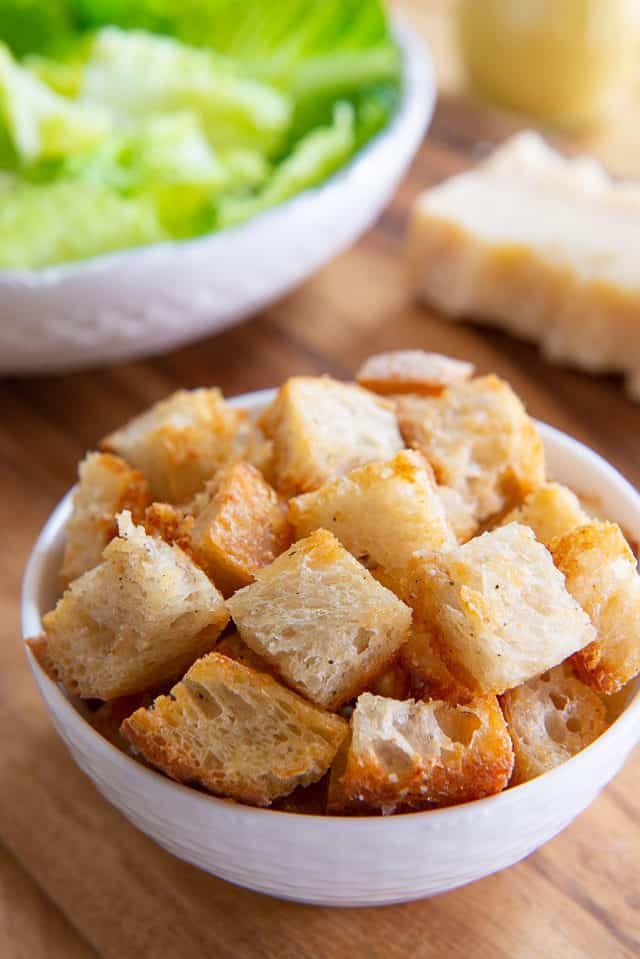
Also don’t forget that what’s fun about homemade croutons is that you can customize them in many different ways. I’ll show you some seasonings and mix-ins you can use below.
What Kind of Bread to Use
The type of bread you use will impact the flavor and texture.
Recommended breads: Sourdough bread is my personal favorite for croutons, but ciabatta, pugliese, paesano, French bread, or any high-quality loaf of bakery bread is perfect. Any whole wheat variety is fine too if you prefer more flavor than the typical white bread.
Not recommended: Baguette is in my opinion too crust-heavy for croutons. On the flip side, white sandwich bread will be too soft, and not have enough crust.
Step by Step Overview:
Start by breaking down your bread. I prefer to cut my loaf into about 1 inch cubes, though you may do any size you like:
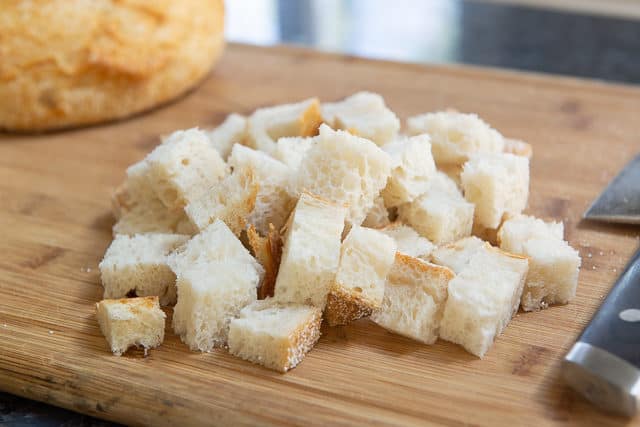
The reason I usually cube the bread is because it’s quick to cut up, and I enjoy the look and texture.
But, you may also tear little pieces of bread for a different texture (as I show in this post I did for the Pioneer Woman in 2015). Torn bread has a slightly more crunchy texture and a more rustic look.
It’s best to use slightly stale bread that’s at least a day old, so the bread is a bit drier from the start, but I’ve used fresh bread when it’s all I had, and it’s still great.
Place the cubed bread into a large bowl, and toss with the seasonings of your choice.
Since I was making these particular croutons for Caesar Salad, I added freshly grated parmigiano reggiano cheese, garlic powder, freshly ground black pepper, and kosher salt:
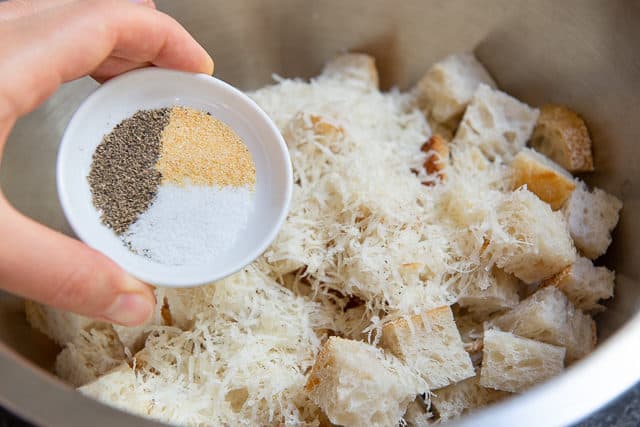
Feel free to play with the seasonings. I often add Italian seasoning or herbs, depending on what kind of salad I’m using the croutons for. I tend to like dried herbs more than fresh herbs here.
If you’re adding cheese like I have, stick with the harder varieties like parmesan cheese or asiago. More aged varieties will give you the best croutons.
Toss well to distribute the seasonings, then toss the bread pieces with your fat of choice:
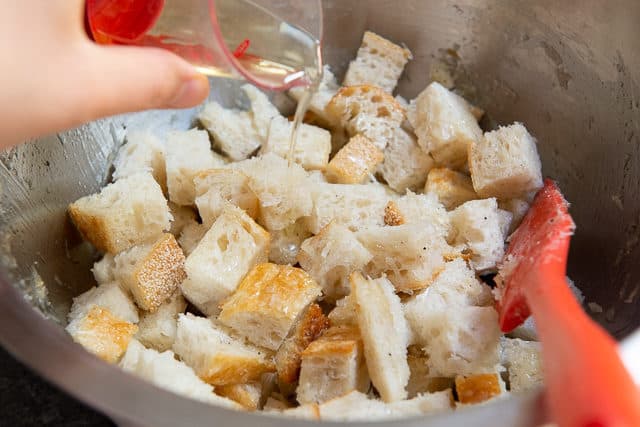
I do olive oil most of the time, but you could also do melted butter or any other type of fat that has a flavor you enjoy, like duck fat or tallow.
Spread the croutons evenly onto a sheet pan in a single layer, giving the croutons space to brown:
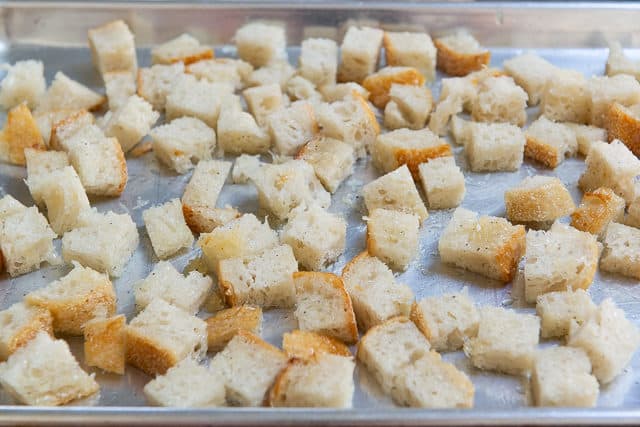
Bake in the oven for 10-15 minutes, until lightly golden brown on the outside.
Note that you don’t want to brown the croutons too much. They are usually crunchier than they look! Once they turn golden, I taste one just to make sure they’re perfect. They should be robustly crunchy on the outside, but still have moisture in the middle, giving it a nice chewiness and hearty texture.
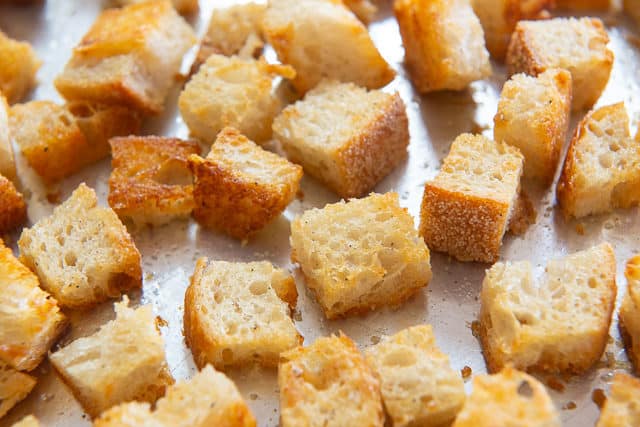
Suggested Uses
Homemade Caesar Salad is the perfect venue for these croutons, though they will jazz up any salad you make at home, like Cobb Salad or Kale Caesar Salad.
While less traditional, croutons are also wonderful when served with creamy soups! Add some to Butternut Squash Soup, Broccoli Cheddar Soup, or even Lasagna Soup.
And I admit to enjoying them straight off the pan as well 😉
Recipe Tips and FAQ
Let cool completely, then store in an airtight container at room temperature for 2 days, or in the fridge for 7 days. If you want to keep them longer, freezing is recommended.
Yes, they freeze beautifully! Let them cool completely, then keep in an airtight container for up to 2 months.
If reheating from the fridge, bake in a 300F oven for about 5 minutes. If reheating from frozen, bake in a 300F oven for 8-10 minutes.
Did you enjoy the recipe? Please leave a 5-star rating in the recipe card below and/or a review in the comments section further down the page. Or, follow me on Facebook, Instagram or Pinterest!
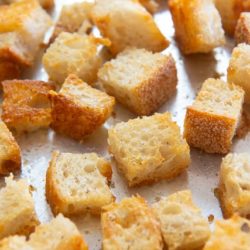
Homemade Croutons
Ingredients
- 6 cups cubed sourdough bread preferably a day old
- 1/4 cup lightly packed grated parmigiano reggiano cheese
- 1/4 tsp garlic powder
- 1/4 tsp salt
- 1/4 tsp black pepper
- 6 tbsp extra virgin olive oil*
Instructions
- Preheat the oven to 400º F.
- In a large bowl, toss to combine the bread, cheese, garlic powder, salt, and pepper.
- Toss the bread with the oil, distributing it as evenly as you can.
- Spread the bread cubes onto a half sheet pan, giving the bread space to brown.
- Bake for about 10-15 minutes**, or until slightly golden brown and crisp on the outside, but still moist inside.
- Let the croutons cool on the tray, and enjoy!
Notes
Nutrition
Nutrition is estimated using a food database and is only intended to be used as a guideline for informational purposes.

One Comment on “Homemade Croutons”
They are cooking now!! Can’t wait to use them in my black bean soup.